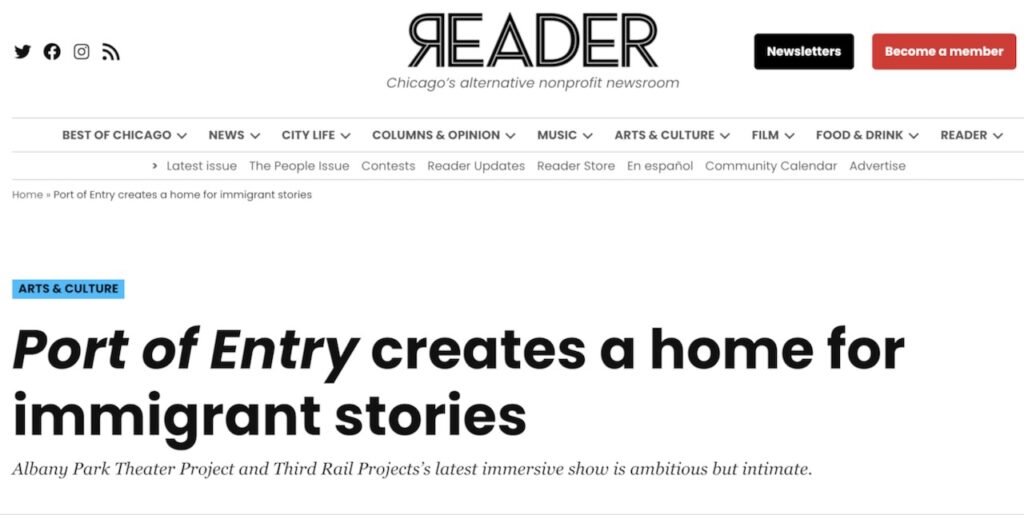Chicago Reader: port of entry creates a home for immigrant stories
Albany Park Theater Project and Third Rail Projects’s latest immersive show is ambitious but intimate.
Chicago Reader
by Kerry Reid
June 28, 2023
In 2016, Albany Park Theater Project [and their collaborators Third Rail Projects] took over the closed Saint Hyacinth Basilica School in Logan Square and transformed it into the fictional Ellen Gates Starr High School for their ambitious (and hugely successful) immersive ambulatory production, Learning Curve. That show took audiences throughout the school—from classrooms to bathrooms—and deep into the experience of being a teenager at a Chicago public high school, with standardized tests, discussions about The Great Gatsby and the American dream, trips to the guidance counselor’s office, and jitters about getting a prom date being just some of the possible scenarios for us to encounter along the way.
Learning Curve was structured so that not every audience member would see every scene. Some were just one-on-one interactions with APTP’s youth ensemble, who as always played all the roles, adults and teens alike. Others were group scenes, where we became part of the student body—right down to the laminated IDs we received at the start of the show.
For their latest immersive production, Port of Entry, the company (with the help of the Logan Foundation) has acquired a building on West Montrose and created a series of apartment settings, complete with a courtyard and back porches, within the 1929 former storage facility. The show takes us through these realistic rooms as we hear stories of immigrant families living within Albany Park.
Parts of the script are culled from the vast archive of community stories collected by APTP’s ensemble members over the decades, while some are new for this show. Given the buzz created by Learning Curve (which ran for around five months) and the fact that audiences for Port of Entry are limited to 28 per performance, it’s no surprise that the initial run of this new show (through August 12) is already sold out. (More tickets will be on sale for the fall shortly.)
But David Feiner, APTP’s cofounder and co-executive director, hopes that Port of Entry will stick around for a long time. Currently APTP plans to run it for at least a year. (The company will also continue to create and rehearse other pieces at their home base in the Eugene Field Park field house.)
Earlier this month, Feiner and co-executive director Miguel Angel Rodriguez took me on a tour of the still-under-construction environments for Port of Entry to get a sense of the scope of this project, which perhaps paradoxically promises to be bigger in its ambitions and more intimate in design and concept than Learning Curve. Like that earlier show, Port of Entry was developed in [collaboration] with…New York’s Third Rail Projects, which specializes in immersive experiential theater. (The Lewis Carroll-inspired hit, Then She Fell, is probably their best-known piece.)
Planning for Port of Entry began in 2018, “right in the middle of the Trump presidency,” Feiner notes. One of the apartments serves as the home for a Mexican family, where they receive a phone call letting them know that the father has been deported. “We were devising that and rehearsing it in the summer of 2019, when there were daily rumors moving around over social media that ICE agents were about to swarm Albany Park communities,” says Feiner.
Rodriguez notes that a big part of the planning for the show was making sure that audiences understand their role in the world of the play. “When you come in, you immediately realize you are supposed to be here. You are a guest who has been here before. You never have to guess who you are. The actors and the storytelling envelope you into the story right away.” So for example, in the home of the Mexican family, Rodriguez says, “You are immediately brought in and invited to sit down. There’s music, and they invite you to play loteria. If you know how to play it, great. If you don’t, you’ll be quickly taught.”
Later in the tour, Rodriguez shows me the fully functioning kitchen in an apartment for a Filipino family, where visitors are invited to help make turon, a traditional fried dessert. As in past APTP shows, including 2010’s Feast (revived in 2015), Rodriguez notes, “We really wanted to show how food is important to so many families and cultures.”n Port of Entry, the theater company, a mix of youth and adult artists, and Third Rail Projects aim to tell the stories of an immigrant community in the Northwest Side neighborhood.

